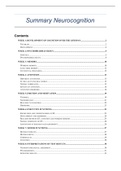Summary Neurocognition
Contents
WEEK 1: DEVELOPMENT OF COGNITION OVER THE LIFESPAN.................................................2
THE BRAIN......................................................................................................................................................2
DEVELOPMENT...............................................................................................................................................4
WEEK 2: PSYCHOPHARMACOLOGY......................................................................................................5
GENETICS.......................................................................................................................................................5
PSYCHOPHARMACOLOGY...............................................................................................................................8
WEEK 3: MEMORY.....................................................................................................................................10
WORKING-MEMORY.....................................................................................................................................10
LONG-TERM MEMORY..................................................................................................................................12
CONTEXTUAL PROCESSING...........................................................................................................................12
WEEK 4: ATTENTION................................................................................................................................13
DIFFERENT ATTENTIONS...............................................................................................................................13
IN THE LAB VS THE REAL WORLD.................................................................................................................15
NEURAL CORRELATES..................................................................................................................................15
EFFECTS OF ATTENTION...............................................................................................................................16
ATTENTION DISORDERS................................................................................................................................16
WEEK 5: EMOTION AND MOTIVATION..............................................................................................19
THEORIES.....................................................................................................................................................19
NEUROBIOLOGY...........................................................................................................................................21
RELATION TO COGNITION.............................................................................................................................22
DISORDERS...................................................................................................................................................23
WEEK 6: EXECUTIVE FUNCTIONS........................................................................................................23
KNOWLEDGE AND UNDERSTANDING OF EF.................................................................................................23
DEVELOPMENT AND DISORDERS..................................................................................................................24
RELATION BETWEEN EF, ATTENTION AND WORKING MEMORY...................................................................25
NEURAL SUBSTRATE OF EF..........................................................................................................................26
LIMITATIONS OF RESEARCH AND ASSESSMENT............................................................................................26
WEEK 7: MOTOR FUNCTIONS................................................................................................................27
MOTOR PATHWAYS......................................................................................................................................27
MOTOR CORTEX...........................................................................................................................................28
CEREBELLUM...............................................................................................................................................29
COGNITION...................................................................................................................................................30
WEEK 8: INTERPRETATIONS OF TEST RESULTS............................................................................30
NEUROPSYCHOLOGICAL ASSESSMENT..........................................................................................................30
PSYCHOMETRICS..........................................................................................................................................31
SCIENTIFIC RESULTS.....................................................................................................................................33
, OPEN SCIENCE..............................................................................................................................................33
LITERATURE...............................................................................................................................................35
1
,Week 1: Development of cognition over the lifespan
The brain
Central nervous system (brain) and
peripheral nervous system (autonomic and
peripheral sensory and motor systems).
Frontal, parietal, temporal & occipital
lobe. Ipsilateral side = same hemisphere.
Contralateral hemisphere = other hemisphere.
Lateralisation symmetry and asymmetry,
many functions are same across inter-
hemispheric. Functional asymmetries.
Gyri and sulci bumps and grooves. Recognisable landmarks. To understand division between
front-back, you must be able to locate central sulcus and sylvian fissure. The sensory (input) regions
are posterior to central sulcus and sylvian fissure. Most of processing of input happens in parietal
lobe. The motor (output) regions are located in frontal lobe, just across somatosensory regions which
allows for tight coupling between touch, pressure and pain and action or motor system. Two
homunculi somatosensory cortex (feeling) and motor cortex (action).
Neurons all look different. Can be in shape and function (sensory, interneurons (stellate (afferent
= towards brain), pyramidal, purkinje), motor (efferent = away from brain)).
Thresholded and non-decremental action potentials. Triggered by summation of excitatory
potentials. Driven by varying ion permeability of cell
membrane.
Synapses action potential leads to neurotransmitter
release into synaptic cleft. Some neurons release more
than one transmitter. Receptor tells postsynaptic
membrane can adapt to under- or over-use. Glia cells
Astrocytes, oligodendrocytes, microglial cells, ependymal
cells, schwann cells.
Brodmann areas small regional differences with
each their own function and unique number. Talairach
coordinates even precise areas than Brodmann areas.
Used in functional imaging. Now even better coordinates
based on 1000s brains.
Grey matter or cortex is outer layer of the brain. Six cellular layers thick. Cortex has a horizontal
and vertical organisation. Vertical one is in columns with layers with Roman numerals starting from
top. Cortical cell layers cells are organised in layers. Sensory, interneurons and motor neurons are
2
, grouped according to function. Layers are in different cortical areas, depending on primary function.
Depending on function, layer for input or output are different thickness.
White matter tracts white because of myelin. Not one homogonous area, but different fibers.
Connecting neurons throughout central and peripheral nervous system, associating fibers(connecting
areas within hemisphere), commissural fibers (crossing to other hemisphere), projection fibers
(connect outward). They’re consistent in layout.
Brainstem is continued with spinal cord. Upper section (pons) connects two halves of cerebellum.
Form major route from spinal cord to brain. Then thalamus which forms upper end of brainstem.
Below is hypothalamus and pituary gland which form neurohormone complex. On top of
hypothalamus is hippocampus inside temporal lobe. Plays role in transferring information to long
term memory. Near top of hippocampus is amygdala which plays role in emotion.
Ventricles open spaces in brain where cerebral spinal fluid is circulating. Lateral ventricles, 3 rd
ventricle, fourth ventricle (small cavities containing circulation fluid and neural stem cells), central
canal. Is created in lateral ventricles from arterial blood in choroid plexus and ependymal cells. Basal
ganglia and caudate nucleus (control of movement and cognition).
Hemispheres are completely separated but linked by large arc of white matter (corpus callosum).
Information between hemispheres goes through corpus callosum with delay as short as 10 ms. Slicing
of corpus callosum to treat epilepsy has hardly any cognitive effect.
Major components of central nervous system forebrain, diencephalon, midbrain, hindbrain
and spinal cord.
Frontal lobe site for motor planning and output. Pre-frontal cortex is non-motor part and most
distinctive cognitive part of brain, specifically needed for executive functions, emotional and
personality processes, social cognition and Broca’s area. Movement, attention, reward, short-term
memory, planning, impulse control.
Parietal lobe important function is multiple maps of body space. The function of inferior
parietal lobe thought to be multisensory integration. Sensory integration, associating processes,
language functions, spatial processing.
Temporal lobe region where sound is processed and where auditory and speech
comprehension systems are located. In inferior and posterior parts also representing visual objects and
fusiform face area. Memory processing, some language processes (object identification), auditory
areas, emotion association.
Occipital lobe home to visual cortex where visual input is processed.
Insula and Sylvian fissure insula is below temporal lobe, involved in gut feeling and
introspection. Sylvian fissure is large sulcus that differs between persons. Includes supratemporal
plane that’s home to primary and secondary auditory cortex and part of Wernicke’s area.
Medial temporal lobe part of temporal lobe but functionally and anatomically different. Home
to hippocampi and regions associated with memory functions. Cingulate gyri are used during tasks
3




